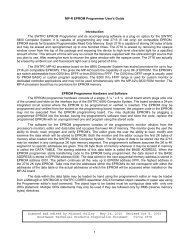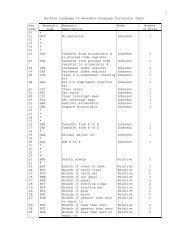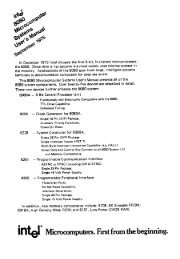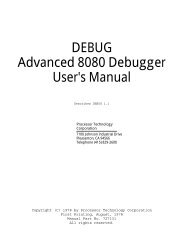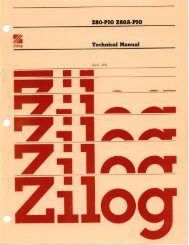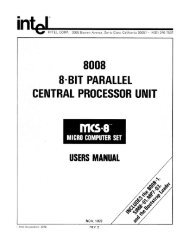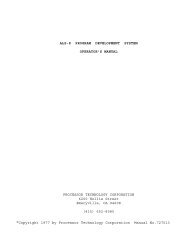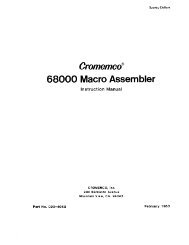The System Manual of SOL-20 - History of Computers
The System Manual of SOL-20 - History of Computers
The System Manual of SOL-20 - History of Computers
Create successful ePaper yourself
Turn your PDF publications into a flip-book with our unique Google optimized e-Paper software.
PROCESSOR TECHNOLOGY CORPORATION<br />
Sol THEORY OF OPERATION<br />
SECTION VIII<br />
As can be seen, Sol's internal memory consists <strong>of</strong> four contiguous<br />
1024-byte pages. <strong>The</strong>re are two pages (C0 and C4, hexadecimal<br />
or hex) <strong>of</strong> ROM, with Page C0 at hex addresses C000 through C3FF and<br />
Page C4 at hex addresses C400 through C7FF. <strong>System</strong> RAM (Page C8) is<br />
at hex addresses C800 through CBFF, and Display RAM (Page CC) is at<br />
hex addresses CC00 through CFFF.<br />
<strong>The</strong> six high order bits <strong>of</strong> the address are decoded in the<br />
Address Page and I/O Port Decoder to supply the required four memory<br />
page selection signals. <strong>The</strong> I/O Port Decoder portion <strong>of</strong> this circuit<br />
decodes the eight high order address bits to provide outputs<br />
that control Data Input Multiplexer switching, Data Bus Driver enablement<br />
and I/O port selection.<br />
<strong>The</strong> video display section consists <strong>of</strong> the Video Display Generator<br />
and Display RAM. <strong>The</strong> RAM is a two-port memory, with the CPU<br />
having the higher priority. Screen refresh circuitry in the Video<br />
Display Generator controls the second port to call up data as needed<br />
for conversion by a character generator ROM into video output signals.<br />
Other circuitry generates horizontal and vertical sync and blanking<br />
signals as well as cursor and video polarity options.<br />
A 1<strong>20</strong>0 Hz signal, extracted from dot clock by a divider in<br />
the Video Display Generator, drives the Baud Rate Generator. This<br />
generator supplies the receive and transmit clocks for the serial<br />
data interface (SDI/UART) and provides ail frequencies required for<br />
Baud rates between 75 and 9600. It also supplies clock signals to<br />
the Cassette Data Interface (GDI).<br />
A UART controls data flow through the Serial Data Interface<br />
(SDI/UART) and provides for compatibility between the Sol and a data<br />
communications system, be it RS-232 standard or a <strong>20</strong> ma current loop<br />
device. In the transmit mode, parallel data on the Bidirectional<br />
Data Bus is converted into serial form for transmission. Received<br />
serial data is converted in the receive mode into parallel form for<br />
entry into the CPU on the Internal Data Bus. SDI/UART status is also<br />
reported to the CPU on the Internal Data Bus. <strong>The</strong> SDI/UART channel<br />
is enabled by the port strobe from the Address Page and I/O Port<br />
Decoder.<br />
Circuitry within the GDI derives timing signals from clocks<br />
supplied by the Baud Rate Generator. <strong>The</strong> Cassette Data UART functions<br />
to 1) convert parallel data on the Bidirectional Data Bus into<br />
serial audio signals for recording on cassette tape, and 2) convert<br />
serial audio signals from a cassette recorder into parallel data for<br />
entry into the CPU from the Internal Data Bus. Note that Cassette<br />
Data UART status is also reported to the CPU on the Internal Data<br />
Bus. Again, a UART performs the necessary parallel-to-serial and<br />
serial-to-parallel conversions. Other GDI circuitry performs the<br />
needed digital-to-audio and audio-to-digital conversions and provides<br />
the signals that allow motor control for two recorders. As with the<br />
SDI/UART, the Cassette Data UART is enabled by a port strobe from the<br />
Address Page and I/O Port Decoder.<br />
VIII-4



